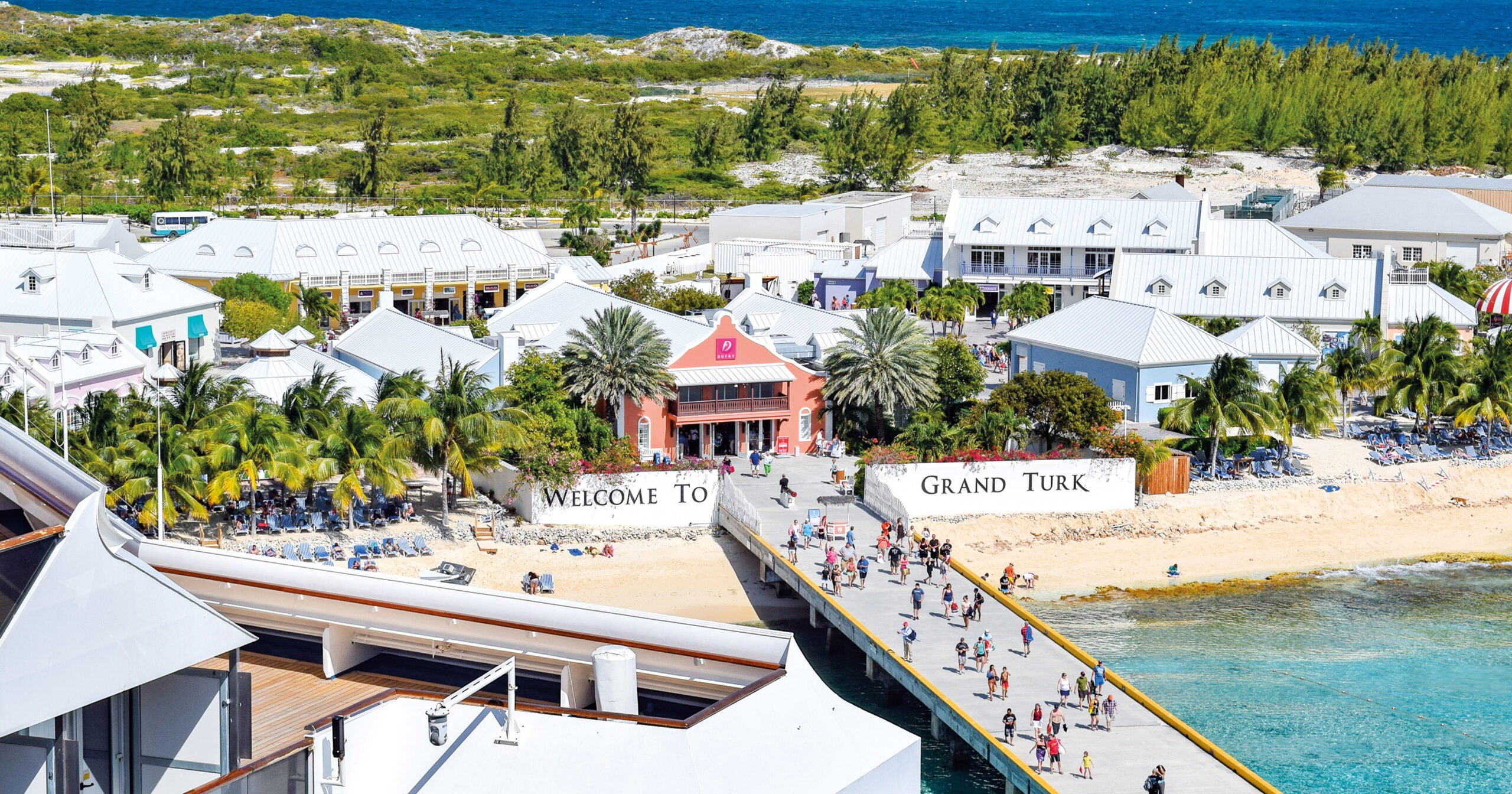I join the crowd of travellers gasping in awe and staring intently heavenwards, as crackling trails of fire and brimstone streak across the sky, stealing the show from the sunset, which had just seen us raising a rum punch to its everyday golden glory.
Like a Red Arrows aerobatics show without the planes, or a fireworks display devoid of Disney hits, smoking stripes of crimson, bronze and azure chase starbursts of dazzling magnesium-white, which cascade into the distance as sonic booms, like nothing I’ve heard or felt before, thunder down from above. Excited theories begin to emerge: maybe a meteor shower or a comet plummeting to Earth? An alien invasion or the end of the world? Any kind of cosmic alchemy seems plausible right now, as we stand, jaws dropped, trying to make sense of what’s happened in the night skies above Providenciales International Airport, in the laidback Atlantic Ocean archipelago of Turks and Caicos.
My last night on the islands is eventful, as I unwittingly witness history, while waiting to board a plane back to the UK after a week of exploring the coral cays and reefs of this British overseas territory. My flight delayed because of the UFOs, I won’t learn the truth until I land at London’s Heathrow the following day – the upper stage of a SpaceX Starship launch system, the most powerful rocket ever built, had broken up just minutes after liftoff from South Texas during a test flight. The last data showed the rocket at 146km altitude, travelling at 13,245 miles per hour, before it exploded, causing a blizzard of debris to rain down over one of the most naturally beautiful places on the planet.
Unwanted fallout
Described as a ‘rapid unscheduled disassembly’ by SpaceX, the rocket explosion miraculously caused no loss of life and damaged only the vehicle. But it left its mark nonetheless, scattering debris – ranging from car- to fingernail-sized pieces – across the archipelago. While we casual observers on the airport viewing deck all marvelled at the spectacle in real time, for those who live and work on the islands, the fallout was yet another man-made challenge that this pristine paradise would have to rise to overcome.
‘A multi-agency “mishap investigation” is taking place, with a response focused on cleanup, but we are still waiting on further updates from the government,’ says Alizée Zimmermann, executive director of the Turks and Caicos Reef Fund (TCRF), a US non-profit organisation established in 2010 with the aim of protecting the marine environment across the archipelago. While some residents have kept remnants of the spacecraft as souvenirs or listed them for sale on ebay – one SpaceX heat tile is on reserve at $3,000 – the TCRF has been working in partnership with the government’s Department of Environment and Coastal Resources to assess the impact of the explosion. TCRF volunteers began recording the location of the debris immediately after the incident, which happened on 16 January 2025. ‘We’re calling for a full environmental impact assessment to understand any long-term risks to marine life and coastal ecosystems, along with funding and a dedicated cleanup task force,’ says Alizée. ‘Technological innovation is going to continue, but there needs to be an increased awareness and understanding of how these innovations and “advances” are impacting our environment. There also needs to be a mitigation procedure in place and environmental funding going towards any nation that experiences the potential fallout of these tests, particularly in regions as ecologically sensitive as the Caribbean.’
Abundance of wildlife
Lying 968km southeast of Miami in the US, Turks and Caicos is made up of more than 100 named islands and cays, just nine of which are inhabited. While considered a Caribbean destination, the isles lie in the Atlantic Ocean, just below the Bahamas, to the east of Cuba, and the coral reefs around the Caicos Bank form the second-largest barrier reef system in the western hemisphere, making it a mecca for snorkellers and divers.
With some of the Caribbean’s most spectacular beaches and clear, turquoise waters, more than 200,000 visitors are drawn to the islands each year. Most locals live on the island of Providenciales or ‘Provo’, home to the international airport, beachfront villas and resorts, while one of the territory’s best-loved stretches of powdery sand, Grace Bay, is where the oceanfront capital, Cockburn Town, lies, along with the cruise-ship port, the beautiful Governor’s Beach, and the Turks and Caicos National Museum, which shares stories of the islands’ salt-producing history, the country’s early indigenous inhabitants, the Taínos and Lucayans, and some of the shipwrecks that lie offshore.
And in Middle Caicos, the largest island in the group, joined to North Caicos by a road causeway, there are secluded, empty beaches, impressive limestone cliffs and Conch Bar Caves, one of the largest cave systems in the Caribbean.
A haven for nature lovers, there are exciting wildlife-watching opportunities both above and below the waves. Almost 150,000 acres of protected national park and nature reserve surround North Caicos and Middle Caicos, with precious mangrove habitat and wetlands that attract herons, egrets, brown pelicans (the territory’s national bird), plus hundreds of West Indian flamingos. More than 3,000 bats inhabit the Conch Bar Caves heritage site, which were the centre of a ‘guano’ mining operation in the 1880s, their droppings exported and used to make fertiliser. Today, you can wander amid the stalactites and stalagmites with a Turks and Caicos National Trust guide to learn more about the bats and the limestone rock formations inside the caverns. The National Trust also protects Iguana Island Nature Reserve, or Little Water Cay, where more than 3,000 critically endangered endemic rock iguanas roam.
Out on the water, whale-watching tours offer opportunities to see humpbacks migrating through the archipelago from January to April, with minke, Sei, Bryde’s and blue whales also found in the Atlantic waters. Bottlenose and spotted dolphins can be seen in the dazzling turquoise seas all year round, and green and hawksbill turtles graze the seagrass beds and cruise the reefs, along with nurse, lemon and grey reef sharks.
Balancing act
Like many of the world’s islands, balancing the needs of tourism and nature is a challenge, one that Alizée and the Turks and Caicos Reef Fund are tackling in collaboration with some of the island’s resorts, like Wymara Resort & Villas on Provo’s Grace Bay. With just three permanent members of staff, TCRF is engaging with local communities, schools and visitors to the islands through fun, educational programmes and by showcasing the organisation’s coral nursery, where key varieties are being propagated. It also organises beach cleanups and installs reef-safe boat moorings around the islands.
Wymara’s support for the Reef Fund comes from practical assistance, awareness-raising and an optional guest surcharge of $5 per night added on checkout. Nominated vegetarian dishes in the resort’s restaurant, Indigo, also attract revenue for the Fund.
‘We understand that, however luxurious our resort is, the reason that many guests choose to come here is because of the natural attractions close by,’ says Wymara chief executive Shelley Rincon. ‘The exceptional marine environment around the islands is one of the highlights for any guest and we want to do everything we can to ensure that we help guests to travel responsibly and sustainably.’ The resort has eliminated all single-use plastics and has worked with local company, The Wildflower Skincare Lab, to produce a range of reef-safe sunscreen.
‘Tourism can be such a force for good, but it can also have a negative impact on the environment if it’s not responsibly managed,’ says TCRF’s Alizée. ‘Cleaning products, landscaping, waste and water management, plastics, toxic sunscreen, overfishing and terraforming can all damage the fragile ecosystems we have here on the islands.’ Just a 15-minute walk from Wymara, along the soft golden sand of Grace Bay, a trail of buoys leads snorkellers safely around a large patch of corals that lie a few metres offshore. It’s in this spot that TCRF will soon plant biobank-lab-grown corals as part of its recovery partnership with the resort.
New threat
In addition to the damage being wreaked on the world’s coral reefs by climate change, warming seas, pollution, acidification and more frequent and stronger hurricanes, a disease known as stony coral tissue loss disease (SCTLD) has devastated reefs throughout the Caribbean since it was first observed in corals off the coast of Miami in 2014, where a large dredging project was taking place. From there, it tracked down the Florida coast to the Dry Tortugas and into the Caribbean, spreading rapidly and affecting some of the slowest-growing and longest-lived reef-building corals, including the brain, star and pillar. Colonies of corals that took hundreds of years to grow were wiped out in weeks. Infected colonies develop white patches that slowly enlarge, draining the colour and life from the animals. SCTLD causes the corals’ tissue to slough off, as if they’ve been covered in acid. So far, it’s estimated to have destroyed between 60 and 80 per cent of coral cover in the region.
‘As is the case with many other coral diseases, we currently know little about what causes this disease, although it does appear to be bacterial in origin, due to success with treating diseased fragments with antibiotics,’ says Michael Sweet, professor of molecular ecology and head of the Nature-Based Solutions Research Centre at the UK’s University of Derby. ‘The agent or agents responsible appear waterborne, likely carried by ocean currents, and the rapid regional spread is being accredited to transmission of the pathogens via the ballast water in commercial ships.’
Precious seascape
Snorkelling offshore near Wymara, the kaleidoscopic coral gardens seem healthy, plied by parrotfish, blue tangs and wide-eyed squirrelfish, and visited by passing turtles. Further offshore, the reef is even more spectacular, with rays and schools of bluehead wrasse and yellowtail snapper, nurse and reef sharks, and submerged gardens of yellow and purple sea fans and elkhorn corals.
‘I was born on Grand Turk and grew up on Provo near Turtle Cove. I could swim before I could walk,’ Alizée tells me, as she leads me through The Bight Park next to Wymara to see the island’s famed Octopus Garden – a mural by Colombian artist Hernan Jurado Quintero, which celebrates the territory’s reefs and the indigenous Taíno and Lucayan people.
‘The reefs I knew as a child are completely different now,’ she says, as local children come up and run their hands over the pink lips of the conch shells, painted delicately on the wall. ‘There are still plenty of wonderful things to see here under the water, but losing my best friend has been one of the hardest things for me: we can work on its recovery with some success, but the reef I knew won’t come back in my lifetime.’
In less than six hours’ time, SpaceX trails would streak across the skies above, raining its man-made debris down on an ocean deceptively vast, but increasingly pushed to its limits. Humans have explored unknown realms since the dawn of time, but in our ambition to reach for the stars, perhaps we need to pause and ask one important question: in our determination to get there, how much of our own planet are we willing to put at risk?
Lauren is a travel writer with a special interest in wildlife, wellness and conservation. Follow her on Instagram @laurenjarvistravels
Lauren travelled to Turks and Caicos Islands with Inspiring Travel, staying at Wymara Resort & Villas. For more information, visit inspiringtravel.co.uk and wymara.com
To support the marine conservation work of the Turks and Caicos Reef Fund, go to tcreef.org; for information about the Turks and Caicos National Trust initiatives, visit turksandcaicosnationaltrust.com; find out more about the islands at turksandcaicostourism.com


